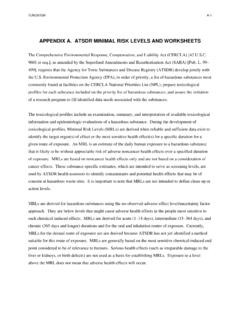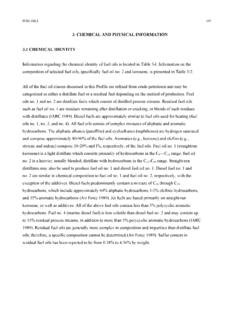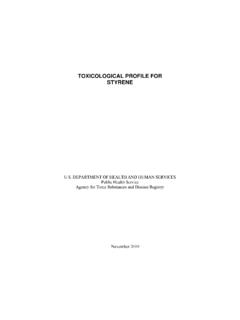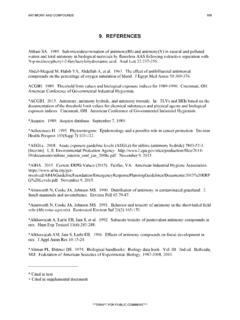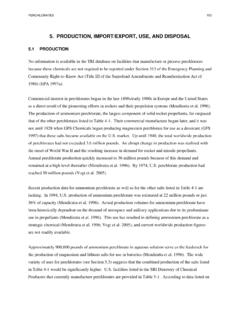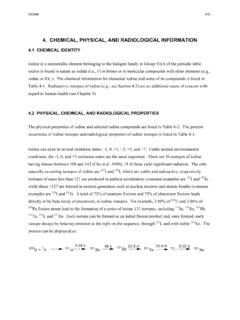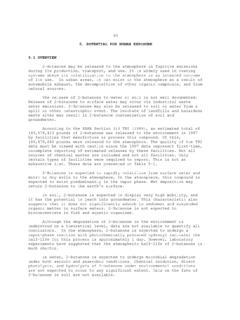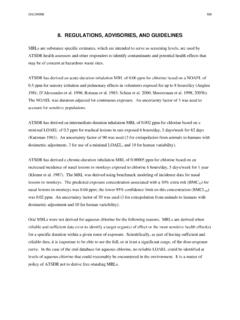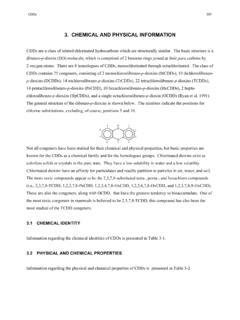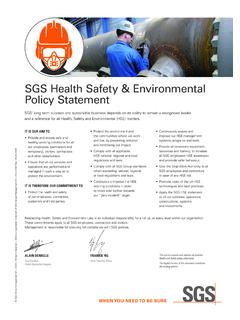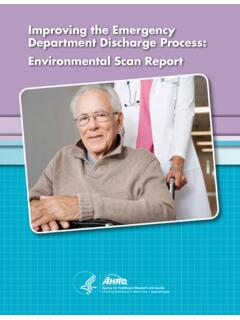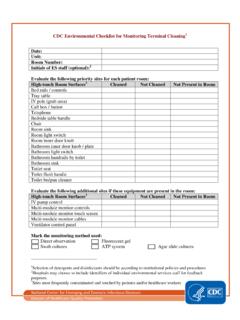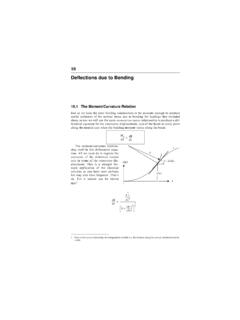Transcription of BENZENE - Agency for Toxic Substances and Disease …
1 ATSDR TOXZINEBENZENE 1 .. BENZENE Overview 2 .. BENZENE and the Environment 3 ..Exposure to BENZENE 5 .. BENZENE and the Body 6 ..Health Effects of Exposure 8 .. BENZENE and Children 9 ..Reducing Risk of Exposure 10 ..Exposure Testing 12 ..Governmental Recommendations 13 ..Additional InformationCONTENTSBENZENE OVERVIEW BENZENE , also known as benzol, is a colorless liquid with a sweet odor. BENZENE evaporates into air very quickly and dissolves slightly in water . BENZENE is highly flammable . Most people can begin to smell BENZENE in air at approximately 60 parts of BENZENE per million parts of air (ppm) and recognize it as BENZENE at 100 ppm.
2 Most people can begin to taste BENZENE in water at 0 .5 4 .5 ppm . One part per million is approximately equal to one drop in 40 gallons . BENZENE is found in air, water, and soil . BENZENE comes from both industrial and natural sources . Industrial Sources and UsesBenzene was first discovered and isolated from coal tar in the 1800s . Today, BENZENE is made mostly from petroleum . Because of its wide use, BENZENE ranks in the top 20 in production volume for chemicals produced in the United States . Various industries use BENZENE to make other chemicals, such as styrene (for Styrofoam and other plastics), cumene (for various resins), and cyclohexane (for nylon and synthetic fibers).
3 BENZENE is also used in the manufacturing of some types of rubbers, lubricants, dyes, detergents, drugs, and pesticides . Natural SourcesNatural sources of BENZENE , which include gas emissions from volcanoes and forest fires, also contribute to the presence of BENZENE in the environment . BENZENE is also present in crude oil and gasoline and cigarette smoke . BENZENE is highly AND THE ENVIRONMENT Industrial processes are the main sources of BENZENE in the is commonly found in the environment . BENZENE levels in the air can be elevated by emissions from burning coal and oil, BENZENE waste and storage operations, motor vehicle exhaust, and evaporation from gasoline service stations.
4 Tobacco smoke is another source of BENZENE in air, particularly indoors . Industrial discharge, disposal of products containing BENZENE , and gasoline leaks from underground storage tanks release BENZENE into water and soil . BENZENE can pass into air from water and soil surfaces . Once in the air, BENZENE reacts with other chemicals and breaks down within a few days . BENZENE in the air can also be deposited on the ground by rain or snow . BENZENE in water and soil breaks down more slowly . BENZENE is slightly soluble in water and can pass through the soil into underground water.
5 BENZENE in the environment does not build up in plants or animals . WaxTarBenzeneGasOil23 EXPOSURE TO BENZENEE veryone is exposed to a small amount of BENZENE every are exposed to BENZENE in the outdoor environment, in the workplace, and in the home . Exposure of the general population to BENZENE mainly occurs through breathing air that contains BENZENE . The major sources of BENZENE exposure are tobacco smoke, automobile service stations, exhaust from motor vehicles, and industrial emissions . Vapors (or gases) from products that contain BENZENE , such as glues, paints, furniture wax, and detergents, can also be a source of exposure.
6 Auto exhaust and industrial emissions account for about 20% of the total national exposure to BENZENE . About half of the exposure to BENZENE in the United States results from smoking tobacco or from exposure to tobacco smoke . The average smoker (32 cigarettes per day) takes in about 1 .8 milligrams (mg) of BENZENE per day . This amount is about 10 times the average daily intake of BENZENE by nonsmokers . Measured levels of BENZENE in outdoor air have ranged from 0 .02 to 34 parts of BENZENE per billion parts of air (ppb) (1 ppb is 1,000 times less than 1 ppm).
7 People living in cities or industrial areas are generally exposed to higher levels of BENZENE in air than those living in rural areas . BENZENE levels in the home are usually higher than outdoor levels . People may be exposed to higher levels of BENZENE in air by living near hazardous waste sites, petroleum refining operations, petrochemical manufacturing sites, or gas stations . About half of the exposure to BENZENE in the United States results from smoking tobacco or from exposure to tobacco most people, the level of exposure to BENZENE through food, beverages, or drinking water is not as high as through air.
8 Drinking water typically contains less than 0 .1 ppb BENZENE . BENZENE has been detected in some bottled water, liquor, and food . Leakage from underground gasoline storage tanks or from landfills and hazardous waste sites that contain BENZENE can result in BENZENE contamination of well water . People with BENZENE -contaminated tap water can be exposed from drinking the water or eating foods prepared with the water . In addition, exposure can result from breathing in BENZENE while showering, bathing, or cooking with contaminated water . Individuals employed in industries that make or use BENZENE may be exposed to the highest levels of BENZENE .
9 As many as 238,000 people may be occupationally exposed to BENZENE in the United States . These industries include BENZENE production (petrochemicals, petroleum refining, and coke and coal chemical manufacturing), rubber tire manufacturing, and storage or transport of BENZENE and petroleum products containing BENZENE . Other workers who may be exposed to BENZENE include coke oven workers in the steel industry, printers, rubber workers, shoe makers, laboratory technicians, firefighters, and gas station employees . As many as 238,000 people may be occupationally exposed to BENZENE in the United AND THE BODY BENZENE can enter your body through your lungs, gastrointestinal tract, and across your skin.
10 When you are exposed to high levels of BENZENE in air, about half of the BENZENE you breathe in passes through the lining of your lungs and enters your bloodstream . When you are exposed to BENZENE in food or drink, most of the BENZENE you take in by mouth passes through the lining of your gastrointestinal tract and enters your bloodstream . A small amount will enter your body by passing through your skin and into your bloodstream during skin contact with BENZENE or BENZENE -containing products . Once in the bloodstream, BENZENE travels throughout your body and can be temporarily stored in the bone marrow and fat.
